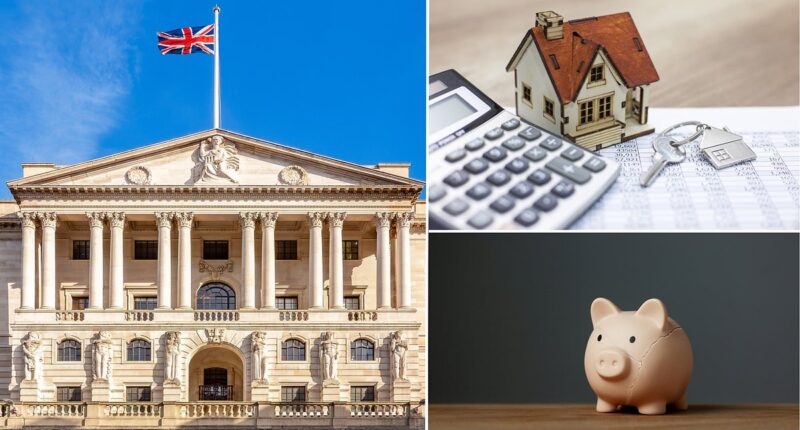The Bank of England cut interest rates today from 4.5 per cent to 4.25 per cent.
The financial markets were not surprised by the decision to reduce interest rates by 0.25 percentage points, as it was widely anticipated by analysts. This cut followed the US Federal Reserve’s decision to keep rates unchanged the previous night.
While this development may be beneficial for those with mortgages, it may not be well-received by savers, as it could lead to a decrease in savings rates offered by banks and building societies.
The last rate decision was made on 20 March, where rates remained unchanged. Today’s rate cut marks the fourth reduction since August 2024, leading to a total decrease of 1 percentage point from the peak of 5.25 per cent.
Crucially, today’s result saw two Monetary Policy Committee members vote for a bigger 0.5 per cent drop in base rate, which indicates rate cut momentum is building.
The next decision is on 19 June. Markets are currently forecasting a further two or three 0.25 percentage point cuts by the Bank of England before the end of the year. This could mean interest rates reach 3.5 per cent by Christmas.
We explain what the Bank of England’s decision to cut rates to 4.25 per cent means for your mortgage and savings – and whether rates will be cut again soon.

Downward trajectory: The Monetary Policy Committee, led by Bank of England governor Andrew Bailey, has voted to cut base rate by 0.25 percentage points
What does this mean for mortgage borrowers?
Today’s decision to cut the base rate to 4.25 per cent will be music to mortgage borrowers’ ears, as falling interest rates tend to lead to lower mortgage rates.
But while some borrowers will see immediate benefits, for the majority it will make little difference in the short term.
This is because lenders usually base their pricing on the longer-term trajectory of interest rates, rather than reacting to individual base rate decisions.
In addition, most borrowers are locked in to fixed-rate deals of two, three or five years, during which time their payments will not change.
However, those on tracker mortgages should see an immediate benefit from the base rate cut, as these rates follow the Bank of England’s base rate plus a set percentage, for example base rate plus 0.75 per cent.
More than 7 million households are on fixed rate deals, representing some 85 per cent of the market, according to UK Finance data. The remainder are mainly either on tracker deals or their lender’s standard variable rate (SVR).
The good news is that mortgage rates have already been falling in the run up to the decision today.
The average two-year fixed rate mortgage has fallen to its lowest point since September 2022, according to Moneyfacts data – just a few weeks prior to the mini-Budget that saw markets panic and mortgage rates skyrocket.
For people looking to buy a home or households looking to remortgage at the moment, many will be able to secure fixed mortgage rates close to 4 per cent.
The lowest two-year and five-year fixes available – for someone buying with a 40 per cent deposit or more – are being offered by Nationwide at 3.84 per cent.
On a £200,000 mortgage being repaid over 25 years that would mean paying £1,038 a month.
Someone buying with a 25 per cent deposit can secure fixed rates as low as 3.94 per cent, while those buying with a 10 per cent deposit can secure rates down to 4.39 per cent.
‘For fixed-rate borrowers, this move could reinforce the downward trend we’ve already been seeing in fixed-rate pricing over recent months,’ says Ravesh Patel, director and senior mortgage consultant at broker Reside Mortgages.
‘But it’s important not to expect overnight transformations—lenders will likely remain cautious until there is a clear trajectory of sustained cuts.’
What next for mortgage rates?
Borrowers wishing to know the future direction of mortgage rates may want to look ar interest rate forecasts.
Mortgage rates have been falling in recent weeks, with the Bank of England now expected to cut interest rates faster than before.
Rates are forecast to fall from 4.25 per cent today to either 3.75 per cent, or more likely, 3.5 per cent by the end of the year.
Fixed-rate mortgage pricing is largely based on Sonia swap rates – the inter-bank lending rate, based on future interest rate expectations.
When Sonia swaps rise sufficiently it often results in fixed mortgage rates going up, and vice versa when they fall.
In the last month, two-year and five-year swaps have fallen from above 4 per cent to just above 3.5 per cent.

Rachael Hunnisett, director of mortgage distribution at lender, April Mortgages
In what has been a competitive market in which the lowest residential mortgage rates have often trended close to the equivalent swaps, this would suggest there may well be more cuts to come.
However, future interest rate cuts are already ‘baked in’ to fixed rate mortgage pricing to some extent, and the trajectory can change based on future predictions.
Rachael Hunnisett, director of mortgage distribution at lender April Mortgages, says: ‘It’s important not to confuse movement in the base rate with meaningful new reductions in fixed mortgage rates.
‘While a base rate cut is welcome news for many, much of this move has already been priced into the market.
Looking ahead, Hunnisett thinks mortgage rates may fall further – but not dramatically so.
‘Markets have already priced in a series of base rate cuts, and lenders have adjusted their pricing accordingly,’ she says.
‘That means any further falls in mortgage rates may be limited unless economic data shifts unexpectedly.
‘Borrowers shouldn’t build their financial plans around the hope of cheaper deals ahead. That’s speculative and could backfire.’
What does this mean for savers?
The base rate affects how much interest savers can earn on their money. In general, savings rates rise when the base rate is rising, and fall when it is falling.
Now that the base rate has been cut to 4.25 per cent, it is almost certain savers will see the best savings rates drop.
Those who keep their cash in easy-access accounts are most at risk of rate cuts.

Rachel Springall of Moneyfacts Compare: Easy-access savers will be at the mercy of a base rate cut
The best easy-access accounts currently pay around 4.75 per cent, tracking reasonably close to the previous base rate of 4.5 per cent.
For this reason, Rachel Springall, finance expert at rates scrutineer Moneyfacts Compare says: ‘Savers who have their cash in easy-access accounts, notice accounts or Isa equivalents will be at the mercy of a base rate cut, because variable rates tend to fall in the aftermath.
James Blower, founder of The Savings Guru adds: ‘Savers should expect their existing provider to be in touch, sometime this month, with news of cuts to their rates.
‘They should also expect the best buy rates to fall from their current levels – around 4.75 per cent – by at least 0.25 per cent as well.
‘We expect to see best buys fall below 4.5 per cent this month.’
What next for savings rates?
If the base rate falls to 3.75 per cent or 3.5 per cent by the end of this year, as markets are currently predicting, fixed-rate bonds are the savings accounts most likely to be in the firing line.
The best one-year bond currently pays 4.55 per cent. This is down from a high of 6.2 per cent in October 2023.
James Blower says: ‘If the base rate is cut further again this year, we are likely to see fixed rates fall quite sharply in the second half of 2025.’
What should savers do now?
Savers should keep a keen eye on their savings rates whether it is an easy-access account, fixed-rate account or an Isa amid a changing interest rate environment.
If your money is not working hard enough for you, move it to an account paying a better rate.

James Blower, founder of the Savings Guru: Fixed-rate bonds are most likely to be in the firing line
Rachel Springall says: ‘Now is a good time for savers to consider a fixed rate bond or Isa, to protect themselves from rate cuts.
‘It is also wise for savers to take advantage of their Isa allowance, as it’s now been a month since the start of the new tax year and there are some competitive cash Isa rates available, but they might not last for long.’
James Blower adds: ‘Keep an eye on what happens to easy-access rates with your savings provider, and switch if it is cut by more than the base rate – or if it is not a competitive rate by comparison to the best buy.’
Best savings rates and how to find them
The best easy-access savings deals pay around 4.75 per cent.
Atom Bank is offering a market-leading easy-access deal paying 4.75 per cent. Someone putting £10,000 in this account could expect to earn £475 in interest after a year, if the rate remains the same.
Those with cash they won’t immediately need over the next year or two should consider fixed-rate savings.
The best one-year deal is offered by Access Bank paying 4.55 per cent. A saver putting £10,000 in this account will earn a guaranteed £4655 interest over one year. It comes with full protection under the Financial Services Compensation Scheme up to £85,000 per person.
Cynergy Bank, GB Bank and Tandem Bank which are also paying 4.55 per cent. All offer FSCS protection.
The best two-year bond pays 4.48 per cent and comes from JN Bank. This provider also offers the best three and five-year bonds which both also pay 4.48 per cent.
Savers should also strongly consider using a cash Isa to protect the interest they earn from being taxed.
Moneybox is currently offering a market-leading 5.71 per cent on its easy-access cash Isa for new customers. But Moneybox’s deal includes a 1.51 per cent bonus for three months. After this the rate will return to 4.2 per cent.
This means it is beaten by CMC Invest*, which offers 5.7 per cent including a 0.85 per cent bonus for three months. The rate will drop back down to a better 4.85 per cent after three months.
In contrast, Trading 212* has a cash Isa paying 5.07 per cent with a 12 month bonus of 0.72 per cent.

















